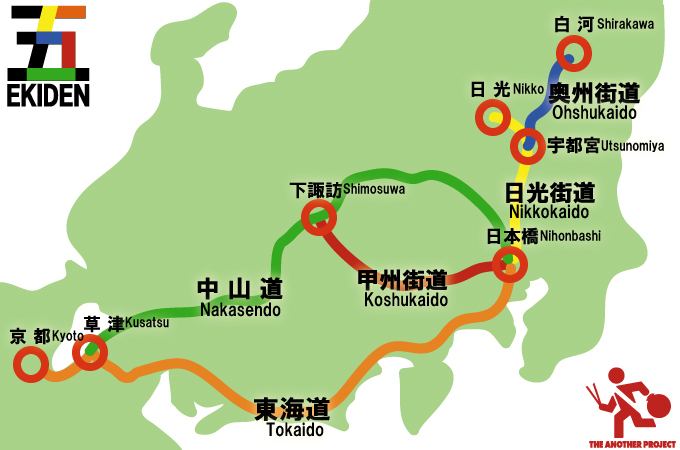 | ||
walking on edo five routes
The Five Routes (五街道, Gokaidō), sometimes translated as "Five Highways", were the five centrally administered routes, or kaidō, that connected the capital of Japan at Edo (now Tokyo) with the outer provinces during the Edo period (1603–1868). The most important of the routes was the Tōkaidō, which linked Edo and Kyoto. Tokugawa Ieyasu started the construction of these five routes to increase his control over the country in 1601, but it was Tokugawa Ietsuna, the 4th shogun of the Tokugawa shogunate and Ieyasu's great-grandson, who declared them as major routes. Post stations were set up along the route for travelers to rest and buy supplies. The routes thrived due to the policy of sankin-kōtai, that required the daimyōs (regional rulers) to travel in alternate years along the routes to Edo.
Contents
History
The various roads that make up the Five Routes existed in some form before becoming an official set of routes. Tokugawa Ieyasu began work on the routes shortly after becoming Shogun in 1600. The official creation of the Five Routes began with the shogunate taking government control of the Post Stations along the existing routes. Before this intervention, the post stations provided places for travelers to rest and ran a courier system. After the official takeover, the Shogunate required that these stations give preferential treatment to those on official business or be forced to cease activity. In the 1640s, Shogun Tokugawa Iemitsu closed down all but the necessary stations, which would be the last major change during the Edo period.
Along with the Post Stations, the government created a system of Check Stations along the Five Routes. Unlike the Post Stations, which provided for travelers, the Check Stations served a regulatory purpose, controlling the movement of people and goods. Some of the uses of these stations were preventing the trafficking of firearms, ensuring that the various rules and policies surrounding the sankin-kōtai were followed, and checking the passports of travelling commoners. Fifty-three Check Stations were created in the 17th century. (This is not to be confused with the 53 Stations of the Tōkaidō, which refers to the Post Stations on the Tōkaidō.)
The shogunate also coordinated general improvements to the roads of the Five Routes. The roads were flattened and widened, with steeper sections paved with rough stone. Trees were planted alongside the road, and drainage ditches were dug in many places. Markers were put up to indicate distance at each ri, which was defined at the time as 2.44 mi (3.93 km) from the starting point at Nihonbashi. While the Five Routes crossed many waterways, few bridges were built. Instead, ferry boats were instituted.
The Five Routes
All five routes started at Nihonbashi in Edo. From that point, each road linked the capital with other parts of the country.
Other official routes
As part of the Five Routes network, eight minor routes were also created by the Shogunate:
Unofficial Routes
In addition to the five routes, there were minor routes that were unofficial branches of or alternates to the main routes, or infrequently used routes. Some of the routes were referred to as hime kaidō, as they were alternate paths for main trade routes, but none were officially called that.
